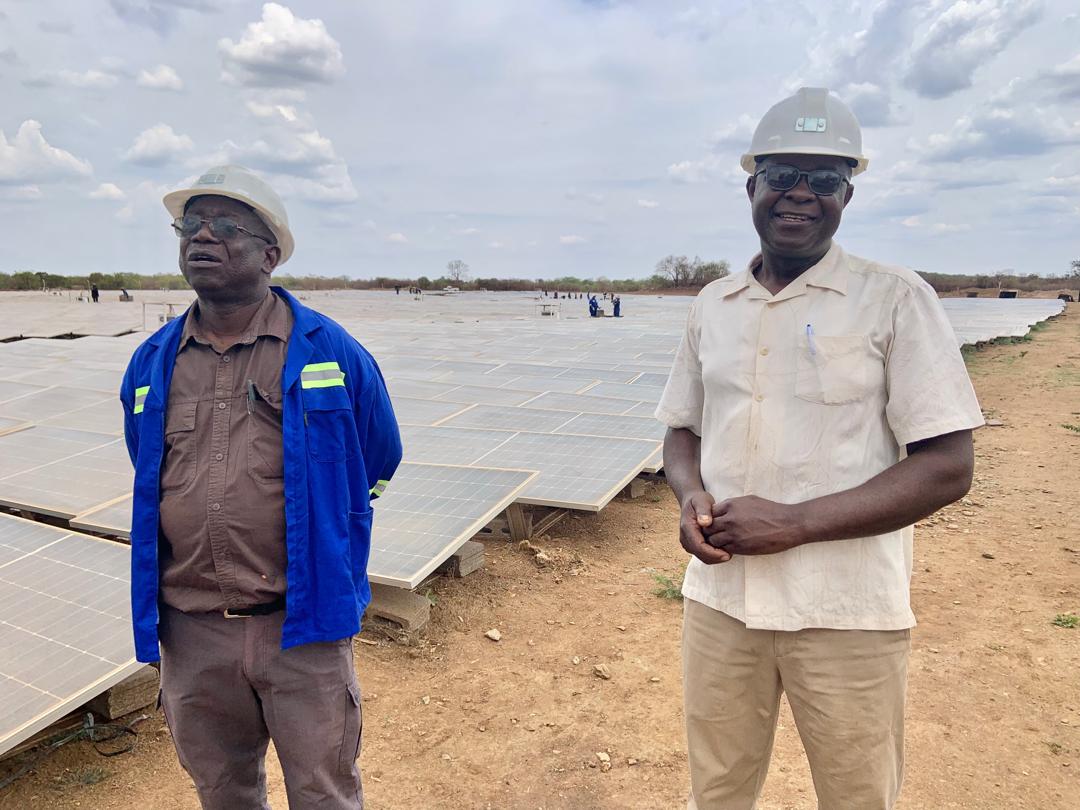Turk Mine in Bubi District, owned by Casymn, has implemented a renewable energy project to generate its own power, reducing operational costs and easing the strain on Zimbabwe’s overstressed Hwange and Kariba power plants.
Initiated in 2022, the solar project produces 4.4 megawatts of power, covering approximately 30 percent of the mine’s needs and providing a reliable energy source that also mitigates environmental impact.
The Turk Mine solar project showcases how renewable energy can transform not only industrial operations but also local communities and the environment and by embracing solar power, the mine has set an example for sustainable mining practices in Zimbabwe.
The project site, once a solid waste dump, was repurposed to support green energy production.
“This area was a dump site for solid waste from gold production, but now it’s a green energy plant,” said Taurai Danda, Turk Mine’s Safety, Health, Environment, and Quality (SHEQ) Officer during a media tour of the solar project on Thursday with the Zimbabwe Energy Regulatory Authority (ZERA).
According to Danda, the mine reclaimed old waste, converting it into an area for solar panel installation.
“This was a positive to us, history has to turn around. Once a dump site, now it’s a green energy plant. It really meant a lot in terms of our environmental laws, where we have to be responsible enough and manage the environment that is around you.
Danda added this initiative not only strengthens Turk Mine’s energy independence but also serves as a model for sustainable development in Zimbabwe’s mining sector.
“I’m happy with this project. If we look closely, whatever we are producing here is enough to run our mine. If we do calculations as environmentalists, it has been proven to say 4.4 megawatts in terms of water, how much water we are going to use. It’s millions of litres of water that we are supposed to use to generate this 4.4 megawatt,” he said.
“In terms of coal, burning of coal to have the same generation, it’s tonnes and tonnes of coal that we are supposed to be used to have this 4.4 megawatt. It’s only not burning the coal, but the emissions, the carbon dioxide, carbon monoxide from that process where we burn the fossil deposits to get energy is another threat to our environment.”
The project’s lead engineer, Wilson Mujuru, explained that the plant operates at approximately six megavolt-amperes (MVA), equivalent to the mine’s peak demand.
The system functions in conjunction with the national grid, using backup generators when needed.
“We are currently not exporting power to the grid, but we have a licence from ZERA to do so if there’s a surplus,” Mujuru explained.
“ZERA gave us a licence after meeting the specifications which they required. We have a net meter there. The net meter is a four-quadrant meter which will say if we have excess mass, we export to the grid and some people can utilise it.”
Mujuru further outlined cost-saving measures, noting that the solar installation saves the mine approximately $80 000 to $90 000 monthly.
“We only export that energy when we have, suppose our mills are down and we are doing maintenance and so forth, or we have excess, then we export to the grid. But currently, we are not doing that,” he noted.
“We haven’t been given the tariff to the grid to be credited back if we have got to put that energy into the grid. Currently, the tariff at peak is $0.23 and at off-peak we are at $0.06. This, the generation of this energy is at $0.79, which is about $0.08. Now we are putting in tax because RBZ requires us to put tax about $0.09.”
The engineer explained that their project provides stable power, especially during peak production times, without adding pressure to the national grid,” he said.
Mujuru said the total cost of investment was US$2.1 million.
“It’s fairly cheap…normally, a plant like this costs about $20 million, but because of the setup, which consists of bricks, which is $0.65 and four on each solar panel,” said the engineer.
Additionally, Mujuru said the solar project significantly reduces Turk Mine’s carbon footprint by decreasing its reliance on coal and the water-intensive processes needed for hydroelectric power.
The solar plant’s setup involved an innovative design, with low-lying solar panels supported by 12.5 kg bricks to anchor them against the wind.
The installation consists of 36 inverters, each producing 400 volts, which are then transformed to the mine’s 550-volt operating requirement.
“It’s a cost-effective project compared to other large-scale energy projects,” Mujuru noted, adding that local workers were employed in the project, benefiting the surrounding community.
Environmental and operational benefits extend beyond energy production.
The engineer said Turk Mine’s solar initiative has also helped to repurpose and stabilise the land around the former dump site, with plans for further improvements such as UV-resistant weed mats to enhance land stability and prevent erosion.
“We are switching off panels in stages to align them with required standards and placing durable materials to control weeds,” Mujuru explained.
This shift to renewable energy offers a significant economic advantage as well. Turk Mine’s reliance on the solar plant cuts costs from $0.19 per kilowatt-hour to about $0.16 per kilowatt-hour, which translates to substantial savings in monthly production costs.
Over a 25-year lifespan, the project is projected to generate significant returns, with a payback period estimated at around ten years.
In terms of community impact, the continuous power supply supports local infrastructure, including boreholes that provide water to nearby areas.
“With this grid connection, we’re stabilising power not just for the mine but also for community essentials like water supply,” Mujuru added.

